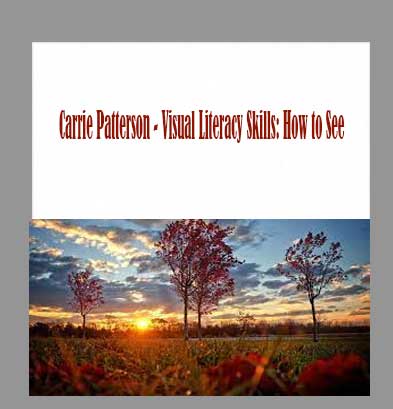Description
Carrie Patterson – Visual Literacy Skills: How to See download, Carrie Patterson – Visual Literacy Skills: How to See review, Carrie Patterson – Visual Literacy Skills: How to See free
Carrie Patterson – Visual Literacy Skills: How to See
Visual Literacy Skills: How to See
Develop the visual skills of artists, designers, and architects in this fascinating journey into visual perception.
LESSONÂ
Trailer
01:Visual Power: What It Is and Why It Matters
First, take into account the dominant role of visual input in the way we perceive, understand, and navigate the world. Consider the value of examining our visual experience and the visual choices we make, as they shape how we think, feel, and act. Practice two experiential exercises that train you to carefully observe what you see, and to explore the visual world through your other senses.
24 min
02:Seeing as a Skill
Begin to explore the components of visual literacy through specific exercises. Grasp how visual literacy involves accurately seeing, describing, and constructing meaning from your experience. Learn about the nature of visual syntax, and the importance of the function and context of what you see. Finally, examine how the modes of representation, abstraction, and symbolism function in art.
27 min
03:Sensing and Perceiving: How You See
Study the anatomy of the eyes, the physiology of seeing, and how the eyes process visual sensations. Then, observe how the brain translates sensation into perception by selecting, organizing, and interpreting information. Look at visual perception using the principles of Gestalt psychology, as the principles describe how the elements of perception are organized into a holistic visual experience.
27 min
04:Should You Believe What You See?
Delve into the most important aspect of our visual experience: the ways we create meaning from what we see. Learn about the nature of human cognitive function and how we conceptualize our perceptions of the world. Explore optical illusions, and how they’re used in Op Art. Then, examine how changing cultural norms affect the work of artists and architects, influencing their visual choices.
24 min
05:Representation and Illusion
How do we define what is real? To begin to answer that question, look into representation in art, and how we value artists’ ability to create the illusion of form and dimension. Observe how photography alters our experience of the world, and how we tend to view photos as “truth.†Grasp the ways in which, in both photography and art, images are “constructed,†and how fact and fiction can overlap.
22 min
06:Elements of Visual Syntax
Visual syntax is the foundation for visual language. Look first at seven formal elements artists and designers use, such as line, shape, color, and texture. Learn about the principles of design that create a composition, including unity, emphasis, and balance. See how these elements and principles are used to create specific effects, by studying historic and contemporary interiors.
21 min
07:Visual Foundations: Dot, Line, and Shape
Take a systematic look at the visual elements artists and designers use in their creative work. Start with the dot, an individual point in space. Observe how artists use dots to establish location, form, and value. Continue with the properties and expressive uses of lines and implied lines in art. Finally, discover the principles of shapes, and study positive and negative space.
22 min
08:Visual Foundations: Value
Continue your study of visual language with value, the degree of lightness or darkness of a hue or a form. Assess value in the work of celebrated artists, and practice exercises that train the eyes to see value. Note how the materials you use influence your work with value, and evaluate the value of colors using a grayscale. Learn to change value in paint colors through tinting and shading.
21 min
09:Visual Foundations: Color
Observe how each human culture possesses a “language†of color, and how we assign meaning to colors. Look at different scientific systems for understanding color, and practice exercises to identify the dimensions of hue, value, and chroma. Grasp how color is relative to its surroundings, and how knowledge of color plays a key role in art, design, architecture, and any visual decision.
26 min
10:Visual Foundations: Texture
Consider texture as a vital component of our interaction with the visual world, noting how we experience texture through both touch and sight. Look into the physiology of touch, and the power of texture to produce strong physical and emotional responses. Explore texture through the techniques of collage, montage, and assemblage, and practice minute observation and the copying of textures.
21 min
11:Visual Foundations: Space
Study how artists and designers create the illusion of space in two dimensions. Begin with shallow space, a compositional approach which stresses the two-dimensional aspect of an artwork. See how artists indicate space and depth through the placement of objects and measuring of proportions within the picture plane. Learn about atmospheric perspective, linear perspective, and projection.
22 min
12:Thinking in Three Dimensions
This lesson explores the principles of three-dimensionality in art. Begin with a study of low relief artworks, where forms stand out against a flat surface, and do a studio exercise creating low relief in clay. Continue with high relief technique in clay, learning to model the volume of a form. Finish with a look at fully three-dimensional art, and create a simple freestanding sculpture.
31 min
13:Building in Three Dimensions
Architecture, design, and 3D art all rest upon knowledge of volume and mass. Grasp the vital role of the materials used in architecture, as they affect structure, volume, and the the experience of a space. Review a case study of a designed house, for its use of volume, material, proportion, and scale. Observe how design must balance volume and mass for both functional and visual concerns.
28 min
14:The Limits of Space: Visual Landscapes
Through landscape, explore how artists and designers navigate the complexities of space. Take a deep look at the rules of linear perspective as they apply both to art and to our immediate experience. Witness how artists capture the disordered sense of built environments through other perspective systems, and how they evoke a sense of timelessness and the infinite in depicting natural landscapes.
30 min
15:Principles of Design
Here, begin to refine and deepen your own skills as a visual communicator. Look first at the nature of composition, the arrangement of visual elements in relation to one another. Then delve into four fundamental principles of design: unity and variety, emphasis, balance, and proportion and scale. Learn specific methods for cultivating and applying these principles in your own life.
21 min
16:Exploring Visual Time
Witness the remarkable ways in which time operates in art and visual communication. Note how the experience of art is influenced by the creation time of the work, the duration of viewing, and how artists capture fixed moments and the progress of time. Practice ways of seeing and expressing time visually, and observe elements such as tempo, implied motion, and real time in visual experience.
21 min
17:Strategies for Visual Storytelling
Unpack the principles behind visual art that conveys a narrative or story. See how a narrative can be expressed within a still image (static visual narrative), within a moving image (dynamic visual narrative), and within a format that requires the participation of the viewer (interactive visual narrative). Practice the skills of static narrative, and learn to convey a story using still images.
23 min
18:Symbol, Subject, Content, and Context
Explore how symbols, subject matter, content, and context work together to create meaning. First, delve into the function of signs, symbols, and logos, and assess their remarkable power. Delineate subject matter in art, in relation to content, the impact or meaning of an artwork. Then grasp the vital importance of context, as it affects our understanding of symbol, subject, and content.
23 min
19:Making Choices: Material, Method, and Style
In art and design, your material, artistic method, and style all carry meaning. Take a thorough look at the matter of choosing your material, and the practical and aesthetic factors bearing on that choice. Observe how the artistic method you employ affects the work and its meaning. Finally, define what style is, and grasp how to develop and express style in your work and your life.
27 min
20:Cultivating Creative Habits
Look at ways to build daily habits that engage your visual skills and cultivate your creative self. Consider taking time at the start of your day to set the stage for creative thinking and work. Study strategies for remaining flexible and open, refining visual consciousness, and capturing creative thoughts, using drawing, reading, and writing. Identify artistic habits that you’d like to grow.
18 min
21:The Visual Life: Active Observation
Investigate what it means to become an intentional active observer. Consider practical ways to challenge or suspend ordinary perception in order to see in new ways and change your perspective. Practice convergent thinking and divergent thinking, non-linear brainstorming, sketching, and other techniques to expand your awareness and strip away assumptions about what you see.
27 min
22:The Visual Life: Exploring and Connecting
Contemplate the essence of innovative thinking, in making connections that may not be obvious within phenomena you observe. Practice pushing your thinking into new areas by arousing curiosity, exploring connections, doing research, and looking at the large picture. Study scenarios that foster original thought, ways to generate ideas, and how to structure a period of creative work.
25 min
23:The Visual Life: Collecting
Examine the human impulse to collect, curate, and appropriate objects, and consider collecting as an essential skill for artists and designers. Observe examples of personal and historical collections, as well as public and private collections, and look into how to begin collecting yourself. Also, learn how to curate and display your own collection, and study guidelines for collecting art.
23 min
24:The Visual Life: Becoming a Maker
Conclude with an inspiring view into the process of creating art and design. Inquire into what type of artistic works attract you, and explore different paths to becoming a maker of art. Learn to set creative goals, set up a workspace, and select materials. Finally, look at how to identify a theme and subject matter, and consider ways to discover your unique creative process.
35 min
DETAILS
Overview
Your ability to derive meaning from what you see is essential in a world suffused with images, and greatly increases your appreciation of art and design. From the works of great masters to the architecture of great buildings and even the design of everyday objects, visual literacy enhances your appreciation and ability to describe the aesthetics of practically anything. These lessons teach you the principles of design as the vocabulary of art √ line, shape, space, texture, color, and more √ and how to see and evaluate them. You learn also how the arrangement of these principles affect the quality of design and art overall. See how clues to a work’s meaning are often communicated in the language of symbols, whether it’s the iconography of a Renaissance work or the colors of a company’s logo. You don’t have to be an artist to appreciate and apply these lessons, though artists and designers will certainly benefit. You just need an active mind ready to see beyond the obvious in any designed art or object.In these 24 lessons, you’ll take a deep look at how the principles and skills of visual literacy directly inform our experience. You’ll learn the formal vocabulary of art, the principles of visual design, how visual language operates, and how to communicate visually. You’ll also learn how to cultivate powers of deep observation, how to generate original thought, and how to create your own art or design.
About
Carrie Patterson
Teaching and making art are inseparable practices. I learned everything I know about teaching from outstanding painters who taught me the importance of passing on the tradition of making objects.
Carrie Patterson is a Professor of Art at St. Mary’s College of Maryland. She earned her BFA in Studio Art from James Madison University and her MFA in Painting from the University of Pennsylvania. Professor Patterson has been with St. Mary’s College of Maryland since 2004, teaching both undergraduate and graduate art courses and working across departments to foster an interdisciplinary approach to art education.
Professor Patterson is also a visual artist whose work considers how color, form, and line can measure and express our physical experiences. Her artwork has been exhibited across the country with solo shows in New York City, Philadelphia, Virginia, and Minnesota, as well as at Museo de Arte Moderno in Bogotá, Colombia. She has received several awards for her work, including the Savelli Painting Award and the graduate teaching award from the University of Pennsylvania, a Virginia Governor’s Fellowship award, and a Seedling Painting Award from the Leeway Foundation.
Through her studio in Leonardtown, Maryland, Professor Patterson promotes lifelong learning with a wide range of art classes for students of all ages and experience levels. She is currently developing an art curriculum for early childhood and K–12 students to encourage the establishment of critical visual literacy skills as part of foundational learning.
REVIEWS
baylou
I’m among those who found this course a bit disappointing. While the premise and topics were interesting, the course seemed to fall flat. I had expected more visual examples, more depth, and more creative insight.
Ann0Â
Very informative and elucidating
In this course the professor teaches concepts from a lot of different disciplines. It is quite challenging and rewarding. I highly appreciate the content and the teaching.








